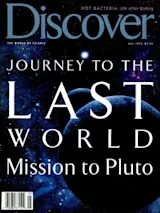Two and a half billion years hence, long after we are gone, Earth will lose its water, and the hardiest organisms will succumb to the sun.
Five billion years from now the sun will balloon into a red giant star and destroy Earth like a mote of dust in a blowtorch. By the time it does, though, our planet won’t be much to cry over. It will have spent its last 2 billion years not as a blue gem of life but as a dry, overheated ball of stone, like Venus.
Such are the grim forecasts coming out of the computer sitting on Ken Caldeira’s desk at Penn State. Caldeira and his colleague James Kasting have been simulating how the evolution of the sun will affect Earth’s atmosphere. On its way to red-gianthood, the sun is getting brighter and hotter; according to astronomers’ star models, it’s about 25 percent brighter ...














